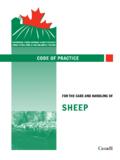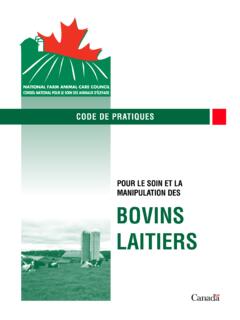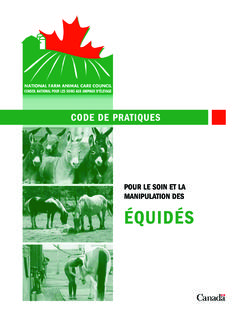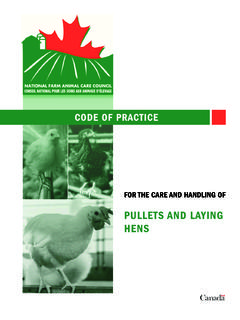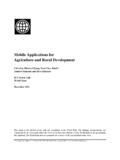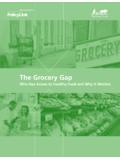Transcription of Recommended code of practice for the care and handling of ...
1 Recommended code of practice for the care and handling of farmanimalsTTransportationransportation Canadian Agri-Food Research CouncilPrinted 2001 Available from Canadian Food Inspection AgencyAnimal Health & Production Division59 Camelot DriveNepean, OntarioK1A 0Y9 Telephone: 613-225-2342 Facsimile: 613-228-6631 For information on the process for the development of a code , please write toCanadian Agri-Food Research CouncilHeritage HouseBuilding No. 60 Central Experimental FarmOttawa, OntarioK1A 0C6 Telephone:613-234-2325 Facsimile: 613-234-2330 Internet: available in FrenchRecommended code of practice for the care and handling of farm animalsCoordinated byCanadian Agri-Food Research Council (CARC)Canadian Federation of Humane SocietiesReview CommitteeParticipants are listed in Appendix 7 Financial ContributionsAgriculture and Agri-Food Canada (AAFC)Canadian Food Inspection Agency (CFIA)iContentsACKNOWLEDGMENTS .. iii Codes developed to COMMENTS AND SECTION 1 animal Duration of SECTION 2 GENERAL CONSIDERATIONS.
2 2 Risk Factors ..3 Pre-Transport Feed and Water SECTION 3 VEHICLES, CONTAINERS AND ..4 SECTION 4 LOADING AND UNLOADING ..6 Access 8 8 8 SECTION 5 CARE AND PROTECTION DURING TRANSIT .. 9 .. 9 in Extreme in Cold in Hot/Humid , Water and iiSECTION 6 ANIMALS AT RISK ..13 ..13 A Guide to handling Livestock at SECTION 7 POST TRANSPORT ANTEMORTEM (PRESLAUGHTER) SECTION 8 SPECIES SPECIFIC AND CLASS SPECIFIC Deer (elk, white tail, mule deer, fallow deer and others)..18 SECTION 9 RESEARCH Appendix Appendix 2 Density Appendix 3 Emergency Procedures ..46 Appendix 4 Guidelines for Humane Killing of Animals by Firearms ..53 Appendix 5 Wind Chill Factors ..59 Appendix 6 References ..60 Appendix 7 Participants ..63 Table 1 Maximum Single Step Height Table 2 Maximum Ramp Slope 7 Table 3 Signs of animal Discomfort During 9 Table 4 Recommended Maximum Transport Times and Minimum Feed, Water and Rest Timeswhich are within the standards of the Health of Animals iiiAcknowledgmentsAcknowledgmentsThe Canadian Agri-Food Research Council gratefully acknowledges the many individualsand organizations who contributed their valuable time, views and expertise to thedevelopment of this code of practice .
3 The development of this code was made possible onlythrough teamwork and cooperation at the national Codes of practice are nationally developedguidelines for the care and handling of the differentspecies of farm animals. The Codes containrecommendations for housing and managementpractices for farm animals as well as transportation Codes are voluntary and are intended as aneducational tool in the promotion of sound managementand welfare practices . The Codes containrecommendations to assist farmers and others in theagriculture and food sector to compare and improvetheir own management 1980, the Canadian Federation of Humane Societiesbegan coordinating the process of development of draftCodes of practice for all livestock species with theintroduction of a Recommended code of practice forHandling of Poultry from Hatchery toSlaughterhouse. The federal Minister of Agricultureand Agri-Food Canada (AAFC) provided financialsupport for the undertaking at that Codes of practice are presently developed by areview committee with representatives from farmgroups, animal welfare groups, veterinarians, animalscientists, federal and provincial governments, relatedagricultural sectors and interested 1993, Agriculture and Agri-Food Canada asked theCanadian Agri-Food Research Council (CARC) and itsCanada Committee on Animals and Expert Committeeon farm animal Welfare and Behaviour to take the leadin cooperation with the Canadian Federation of HumaneSocieties in updating existing Codes and developing newCodes.
4 CARC officially agreed to take on thisresponsibility in February 1995 upon confirmation offunding from Agriculture and Agri-Food 1996, CARC with the support of the provincialgovernments began producing four page factsheets inboth English and French for such uses as teachingagriculture in the classroom, agricultural fairs developed to date:SpeciesOriginalRevisionPoultry19831 989 Pigs19841993 Veal calves19881998 Ranched mink1988 Ranched fox1989 Dairy cattle1990 Beef cattle1991 Sheep1995 Farmed deer1996 Horses1998 Transportation2001_Further information on the process of code developmentand revision can be obtained from the Canadian Agri-Food Research Council (CARC), Heritage House,Building 60, Central Experimental farm , Ottawa,Ontario K1A 0C6. Requests for copies of the Codescan be addressed to the Canadian Food InspectionAgency and/or specific provincial organizations.
5 The CARC Home Page is forfurther contained in this publication is subject toperiodic review in light of changing transportationpractices, government requirements and regulations. Nosubscriber or reader should act on the basis of any suchinformation without referring to applicable laws andregulations and/or without seeking appropriateprofessional advice. Although every effort has beenmade to ensure accuracy, the Review Committee shallnot be held responsible for loss or damage caused byerrors, omissions, misprints or misinterpretation of thecontents hereof. Furthermore, the Review Committeeexpressly disclaims all and any liability to any person,whether the purchaser of this publication or not, inrespect of anything done or omitted, by any such personin reliance on the contents of this Canadian Agri-Food Research Council(CARC) Conseil de recherches agro-alimentaires duCanada (CRAC), 2001.
6 All rights reserved. viiREADERS COMMENTS AND SUGGESTIONSThe Canadian Agri-Food Research Council would like to receive your comments and suggestions on the RecommendedCode of practice for the Care and handling of farm animals - Transportation. Please send the completed questionnaireto the Canadian Agri-Food Research Council at Building 60, Central Experimental farm , Ottawa, Ontario K1A 0C6 orfax to (613) 234-2330. Feedback will be considered in future work involves:a)commercial transportation of farm animals b)raising farm animals c) animal care/ handling at an auction market d)other (please specify) transportation code is relevant or useful in my work:a)highly b)to some degree c) not Additional organization of the code contents:a)is appropriate b)needs improvement (please specify) topics contained in the code cover all appropriate aspects of farm animal transportation:a)yes b)no (please specify) recommendations are presented:a)in an unclear manner or with inadequate detail b)clearly and in adequate detail c)in excessive detail Additional comments:_____6.
7 I suggest the following changes to improve the transportation code (use additional sheets if necessary to commenton any aspect of the code such as content, format or cover design). Recommended code of practice for the Care and handling of farm animals - Transportation " 1 Section 1 " IntroductionCodes of practice strive to promote acceptablestandards of animal husbandry and handling . This codeis intended to achieve a workable balance between thebest interests of the animals and the transportationindustry. Transportation can be one of the most stressfulsituations an animal experiences and can cause anumber of physiological and behavioural changes (seereference material for further reading). This coderecognizes the basic principle that humaneness towardsanimals is the prime consideration in animaltransportation and that animals which are treated welland protected from stress arrive at their destination infar better physical and mental condition.
8 This translatesinto significant benefits and economic advantages nomatter what the reason for transport. As discussed in the preface, this code is voluntary. Allprovincial and federal acts and regulations takeprecedence. The word must is used where there is anenforceable statutory requirement and should is used toemphasize the importance of a point. This code , ingeneral, is intended for use as a guide and educationaltool in promoting sound animal transportation andwelfare practices . It should be noted, however, thatvoluntary Codes have been accepted as the standard ofpractice and have been recognized as such by thecourts. This code will be updated from time to recommendations contained herein do not claim tobe comprehensive for all circumstances but attempt todefine high standards for livestock transportation on aspecies by species basis. This code can serve as aguide to commercial transporters, producers andhobbyists in assessing their facilities, equipment andpractices with regard to livestock transportation and mayprovide guidance for improvement in deficient and handling regimes are subject tochange as market practices evolve, research iscompleted and technology develops.
9 The livestocktransportation industry must continuously keep abreastof new research and technological advances in facilitiesand equipment to enhance transportation practices andensure that animals are transported in the most humane,safe and effective manner possible for the benefit ofboth humans and code is for transport of animals by road. For airtransport refer to the International Air TransportAssociation (IATA) live animals regulations (Appendix6). animal BehaviourAnimal behaviour is a prime consideration in thetransportation of animals. A transporter with a thoroughknowledge of the behaviour patterns of the species he orshe is hauling can significantly reduce the amount ofhandling and goading needed to move, load or knowledge of behaviour patterns encompasses suchthings as flight zones, parameters of vision (such as fieldof view, depth perception, colour perception and generalvisual acuity), probable responses to stimuli and socialbehaviour.
10 This knowledge also allows a transporter toassess such things as loading facilities, problems likely tobe encountered in loading or unloading, segregationneeds, general fitness of the animals to be transportedand signs of distress in animals during should be emphasized that a thorough knowledge ofthe transportation of one species does not ensuresuccess in the transportation of another. Behaviourpatterns are species specific and facilities or practicesthat work well with one species are often ineffective oreven dangerous with another. Such things as flightzones, herding instinct and instinctive responses varysignificantly among species and even between lots ofanimals of the same species which have been raisedunder differing husbandry conditions. It is thereforeimperative that commercial transporters and thoseengaged in the transport of multiple species have athorough knowledge and understanding of expectedbehavioural differences, handling techniques andequipment needed for each species of animal that theymust transport.

